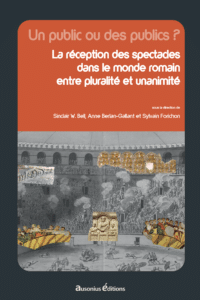UN@ est une plateforme d'édition de livres numériques pour les presses universitaires de Nouvelle-Aquitaine
Auteur : Sinclair W. Bell

School of Art & Design
Northern Illinois University
1425 W. Lincoln Highway
DeKalb, IL 60115
USA
sinclair.bell@gmail.com
0000-0003-2194-8936
Northern Illinois University
1425 W. Lincoln Highway
DeKalb, IL 60115
USA
sinclair.bell@gmail.com
0000-0003-2194-8936
Sinclair Bell is a Classical Archaeologist and Professor of Art History at Northern Illinois University, where he teaches courses on Egyptian, Greek, Etruscan, and Roman art and architecture. He studied Classical Archaeology at the University of Oxford, the University of Cologne, and the University of Edinburgh, where he received his Ph.D. in Classics in 2004. He has excavated at sites in Italy and Tunisia and interned in museums in Germany and Greece.
Additionnal contents
Symposium—Chroma: Ancient Sculpture in Color, Day 2 (©The Met, 03/2023).
Rome’s Chariot Superstar (©Smithsonian Channel, 2019).
Keywords
Roman art, Roman archaeology, Etruscology, Roman spectacles, Roman slavery
Les spectacles de l’Empire romain (compétitions athlétiques, jeux scéniques, combats de gladiateurs et jeux du cirque) rassemblaient généralement des foules hétéroclites comprenant entre autres des magistrats, sénateurs, chevaliers, plébéiens, esclaves, femmes, enfants…
At the end of this collective study, several essential points emerge from the various contributions that are brought together in this volume.
Au terme de cette étude collective, plusieurs points essentiels se dégagent des diverses contributions réunies dans ce volume.
Les spectacles de l’Empire romain (compétitions athlétiques, jeux scéniques, combats de gladiateurs et jeux du cirque) rassemblaient généralement des foules hétéroclites comprenant entre autres des magistrats, sénateurs, chevaliers, plébéiens, esclaves, femmes, enfants…
Since the publication in 1976 of P. Veyne’s work Le pain et le cirque, academic research concerning public performances in the Roman world has experienced an “explosion of bibliography”, to borrow the expression of K. Coleman and J. Nelis-Clément. This growth over several decades of research studying the ludi and the munera in the Roman world has made it possible to considerably advance our knowledge of the realia of shows and of the buildings that hosted them.
Depuis la publication en 1976 de l’ouvrage de P. Veyne, Le pain et le cirque, la recherche universitaire concernant les spectacles publics dans le monde romain a connu une “explosion of bibliography”, pour reprendre l’expression employée par K. Coleman et J. Nelis-Clément.


